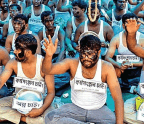The power of two

Politics, like money, never sleeps. Nor does Narendra Modi. Or so it seemed in 2019 when the prime minister was perennially in fast-forward mode, working punishing hours even on holidays and setting a scorching pace that his colleagues and rivals found hard to match. On Christmas Day, for instance, he chose to launch the Atal Bhujal Yojana, aimed at improving groundwater levels in 8,300 villages in seven states. Modi may have turned 69 this September, but he remained indefatigable in pushing through a radically new national agenda that he and the Bharatiya Janata Party (BJP) had set in a year full of tumult, trials and tribulations.
Ironically, the year had begun on a bleak note for Modi. His political ratings were plummeting and the BJP had just lost the three crucial north Indian states of Madhya Pradesh, Rajasthan and Chhattisgarh in December 2018 to the Congress. The economy was on a slippery slope, with GDP growth beginning to falter (it dropped dramatically in the next two quarters). There was much good that Modi had done on the social development front in his first term, including building millions of toilets, providing gas connections and housing for the rural masses. However, an adventurist demonetisation and poorly-executed reform such as the Goods and Services Tax (initially lauded for its good intention) had impacted employment adversely. It may have also resulted in what Arvind Subramanian, a former chief economic advisor to the Modi government, termed the great slowdown of the Indian economy.
Then, in February, in one of the deadliest terror attacks in Jammu and Kashmir in three decades, a suicide bomber rammed an explosives-laden SUV into a CRPF convoy, killing 40 security personnel in Pulwama. Two weeks later, Modi lived up to his reputation as a risk-taker by ordering Indian Air Force jets to strike a militant camp in Balakot inside Pakistani territory the first such operation since the Indo-Pak war in 1971. The IAF then handled Pakistan's riposte, even though it lost an aircraft. Indian pilot Abhinandan Varthaman, too, was captured, but Modi managed to muster enough international pressure to force his Pakistan counterpart, Imran Khan, to release him. In ordering the airstrike, Modi showed steel and sent a clear message to Pakistan that, unlike in the past, India would not shy away from retaliating if our neighbour continued to abet terror.
This was the moment that turned the tide in favour of Modi and the BJP in the general election in May 2019. In his quest for re-election, Modi was ably assisted by BJP president Amit Shah, with whom he shares a guru-shishya relationship. Far from being complacent after the 2014 victory, Shah honed the party into an even more formidable fighting machine, its strength reaching 180 million in August, making it arguably the largest democratic political party in the world. He also finessed the
You’re reading a preview, subscribe to read more.
Start your free 30 days





